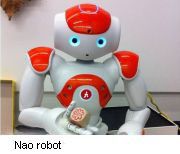Decrease in parent-rated ASD-related symptoms over time with PRT using humanoid robot
THURSDAY, May 10, 2018 (HealthDay News) — Parent-mediated pivotal response treatment (PRT) using a humanoid (NAO) robot may be effective for reducing autism spectrum disorder (ASD)-related symptoms in young children, according to a study presented at the annual meeting of the International Society for Autism Research, held from May 9 to 12 in Rotterdam, Netherlands.
Iris Smeekens, from the Radboud University Medical Center in the Netherlands, and colleagues examined the effectiveness of a NAO robot within parent-mediated PRT in young children with ASD. Seventy-four children aged 3 to 8 years with ASD were randomized to either parent-mediated PRT using the NAO robot (PRT+robot), parent-mediated PRT, or treatment as usual (TAU). Parents were trained in use of PRT techniques; the robot was added in all parent-child sessions in the PRT+robot condition.
The researchers found that in the PRT+robot condition, there was a significant main effect of time and a time × group interaction effect on the Social Responsiveness Scale completed by parents, indicating a steeper decrease in ASD-related symptoms over time. Compared with both the PRT and TAU conditions, the percentage of clinical responders on the Clinical Global Impression-Improvement Scale was significantly higher in the PRT+robot condition (66.7 versus 36.4 and 36.4 percent, respectively) at week 20, but not at follow-up.
“The use of robotics in PRT may be an effective treatment component in diminishing ASD-related symptoms and improving general clinical functioning in young children with ASD,” the authors write.
Copyright © 2018 HealthDay. All rights reserved.








